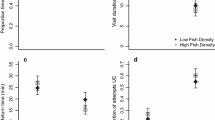Abstract
The foraging behavioral responses of individuals from two color morphs of the common goldfish (Carassius auratus) to a foraging predator, the little egret (Egretta garzetta) were tested in two artificial theaters, each containing three fish ponds. Each pond contained two distinct microhabitats for the fish: 1. A safe microhabitat: a sheltered area under an opaque cover at the center of the pool providing a refuge but no food. 2. A risky microhabitat: the rest of the pool area, where the fish could feed but were exposed to predation by egrets. This experimental design forced the goldfish to trade off food and safety, and to manage risk via time allocation to each microhabitat. The foraging behavioral responses of the gold variant and the bronze variant goldfish, one morph at a time, were quantified. In the presence of an egret, bronze morph fish spent significantly more time out of cover and more fish emerged from under the cover at any given time than did the gold morph fish. Despite the greater exposure of bronze morph fish, they were captured significantly less often by the egrets. These findings strongly suggest that differently colored fish may perceive predation risk differently, trade off food and safety differently, and may have different susceptibility to predators. Our results show that color variation in goldfish may affect both foraging behavior and anti-predatory behavior.



Similar content being viewed by others
References
Annett CA (1986) Differential predation on colour morphs of the Midas cichlid, Cichlasoma citrinellum. University of California, Berkeley
Annett CA (1989) Differential predation on color morphs of the Midas Cichlid, Cichlasoma-Citrinellum. Anim Behav 37:935–942
Brown JS (1988) Patch use as an indicator of habitat preference, predation risk, and competition. Behav Ecol Sociobiol 22:37–47
Brown JS, Kotler BP (2004) Hazardous duty pay and the foraging cost of predation. Ecol Lett 7:999–1014
Brown JS, Laundré JW, Gurung M (1999) The ecology of fear: optimal foraging, game theory, and trophic interactions. J Mammal 80:385–399
Dill LM (1987) Animal decision making and its ecological consequences: the future of aquatic ecology and behaviour. Can J Zool 65:803–811
Endler JA (1978) A predators view of animal color patterns. Evol Biol 11:319–364
Holopainen IJ, Tonn WM, Paszkowski CA (1997) Tales of two fish: the dichotomous biology of crucian carp (Carassius carassius (L.)) in northern Europe. Ann Zool Fenn 34:1–22
Hugie DM (2003) The waiting game: a “battle of waits” between predator and prey. Behav Ecol 14:807–817
Katz MW, Abramsky Z, Kotler B, Altstein O, Rosenzweig M (2010) Playing the waiting game: predator and prey in a test environment. Evol Ecol Res 12:793–801
Katz MW, Abramsky Z, Kotler B, Rosenzweig M, Alteshtein O, Vasserman G (2013) Optimal foraging of little egrets and their prey in a foraging game in a patchy environment. Am Nat 181:381–395
Kittilsen S, Schjolden J, Beitnes-Johansen I, Shaw J, Pottinger T, Sørensen C, Braastad B, Bakken M, Øverli Ø (2009) Melanin-based skin spots reflect stress responsiveness in salmonid fish. Horm Behav 56:292–298
Kushlan JA (1978) Feeding ecology of Wading birds. In: Sprunt IV, Ogden JC, Winckler S (eds) Wading birds. National Audubon Society, New York, pp 249–297
Lewis WM, Gunning GE, Lyles E, Bridges WL (1961) Food choice of largemouth bass as a function of availability and vulnerability of food items. Trans Am Fish Soc 90:277–280
Lima SL (1998) Nonlethal effects in the ecology of predator–prey interactions. Bioscience 48:25–34
Lima SL, Dill LM (1990) Behavioral decisions made under the risk of predation: a review and prospectus. Can J Zool 68:619–640
Sih A (1980) Optimal behavior: can foragers balance two conflicting demands? Science 210:1041–1043
Sternalski A, Bretagnolle V (2010) Experimental evidence of specialised phenotypic roles in a mobbing raptor. Behav Ecol Sociobiol 64:1351–1361
Van den Brink V, Dolivo V, Falourd X, Dreiss AN, Roulin A (2011) Melanic color-dependent antipredator behavior strategies in barn owl nestlings. Behav Ecol 23:473–480
Venesky MD, Anthony CD (2007) Antipredator adaptations and predator avoidance by two color morphs of the eastern red-backed salamander, Plethodon cinereus. Herpetologica 63:450–458
Willink B, Brenes-Mora E, Bolaños F, Pröhl H (2013) Not everything is black and white: color and behavioral variation reveal a continuum between cryptic and aposematic strategies in a polymorphic poison frog. Evolution 67:2783–2794
Acknowledgments
This study was funded by the Israel Science Foundation (ISF; grant number 485/08). The experiments were conducted in accordance with the ethical guidelines for animal research established and approved by the University Committee for the Ethical Care and Use of Animals in Experiments at Ben-Gurion University of the Negev (Authorization Number: IL-49-10-2010).
Author information
Authors and Affiliations
Corresponding author
Rights and permissions
About this article
Cite this article
Katz, M.W., Abramsky, Z., Kotler, B.P. et al. All that glitters is not gold: different anti-predatory behavior of two color morphs of goldfish (Carassius auratus). Environ Biol Fish 98, 377–383 (2015). https://doi.org/10.1007/s10641-014-0268-1
Received:
Accepted:
Published:
Issue Date:
DOI: https://doi.org/10.1007/s10641-014-0268-1




